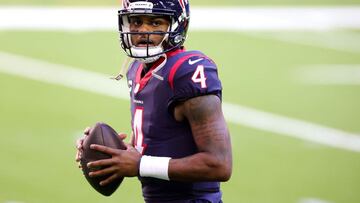What is dead money in the NFL and which team has the most?
Also known as 'cap money', there is debate about just how it is calculated in the NFL, but its purpose is to act for accountability and player protection.

Do you sometimes feel like NFL teams release players whenever they want? Does that feel like it could be a little unfair to some of the parties involved? Well, there are plenty that do, but the teams involved are very aware of the consequences that can come from this and something known as 'dead money' is one of them.
What exactly is dead money?
It can be confusing for some fans today when considering how NFL contracts work. Does it even matter if a player signs a multi-million dollar contract for five years when the team can cut him in an instant? That's where dead money comes into play.
In the NFL the term is used to describe money that counts against a team’s salary cap attributed to players who were prematurely traded or released from the roster relative to their contract.
More from around the NFL:
- La’el Collins new bodyguard for Burrow
- The most important deals done on day seven of NFL free agency
- Matthew Stafford extends his contract with LA Rams
- Odell, Jameson options for Packers to fill Adams void
- Logan Ryan and Tom Brady are reuniting
How does dead money work in the NFL?
Though there is much debate about how dead money is calculated in the NFL, it is in principle a form of accountability where players are concerned, while simultaneously enforcing restrictions on team expenditure. If for example, a player signs with a team on a three-year contract for $9 million in guarantees, the guaranteed money would of course be divided into $3 million instalments per season.
If the player performs below par in his first season, the team can and may choose to terminate his contract prematurely. That doesn't mean however, that upon his release, they don't have to pay the amount owed - some $6 million across the two remaining years.
Does releasing a player affect their salary cap?
At this point the released player in theory only registers against their cap for the one season that they retained him. Enter dead money. This acts as a checks and balances system to ensure that teams face up to cap related protocols regardless of whether or not the player is still with them.
It’s never good when you have to release a statement explaining why you chose to trade for someone & give them the most guaranteed money in NFL history. I’m sure this will smooth things over 😕 https://t.co/OqppRVUb6s
— Michael Lee (@MrMichaelLee) March 20, 2022
In keeping with this, the previously exampled player must be compensated and included across the next two years in the team's salary cap. Those funds are subtracted from whatever the salary cap figure stands at, which in turn limits the the money available for new player signings across the next two years.
The dead money debate
Dead money in some ways offers an insight into the conflict between the sporting aspect of a team and the business aspect. While a player may actually be past his prime according to the coach's evaluation, his dead money value might hinder the team across future seasons.
In that specific scenario we can appreciate the challenge involved in balancing the books and producing on the field.
Which team has the most dead money and how to avoid it?
It can get can quite difficult to build when your hands are tied. And this is exactly the case when having a cap on what you can spend when time comes to make improvements. At the time of writing, the Falcons have taken on a $40.5 million dead cap charge by trading away Matt Ryan. Would you believe that that's the largest dead cap charge in NFL history. You can track all the latest salary cap info with spotrac.
Matt Ryan passed Carson Wentz for a team taking on the largest dead cap hit in #NFL history.
— Jeff Kerr (@JeffKerrCBS) March 21, 2022
Ryan -- $40,525,000
Wentz -- $33,800,000
The #Colts traded for both these QBs. #Falcons #Eagles
Related stories
Yet there are some teams who navigate the tricky world of contract negotiation much better than others. A simple solution is to not agree to guaranteed money across seasons - this is even more interesting when considering the effects of something like, say, a pandemic.
NFL Dead Cap Leaders
— Spotrac (@spotrac) March 21, 2022
1. #Falcons, $62M
2. #Texans, $51M
3. #Bears, $48M
4. #Seahawks, $44M
5. #Eagles, $36M
(Post June 1st releases not yet included)https://t.co/lSUFgEJ1Xu
But it's a double edged sword as receiving more in a shorter space of time can often result in the decline of the effort made by the player. None the less it has proven an effective strategy when safeguarding against dead money.

